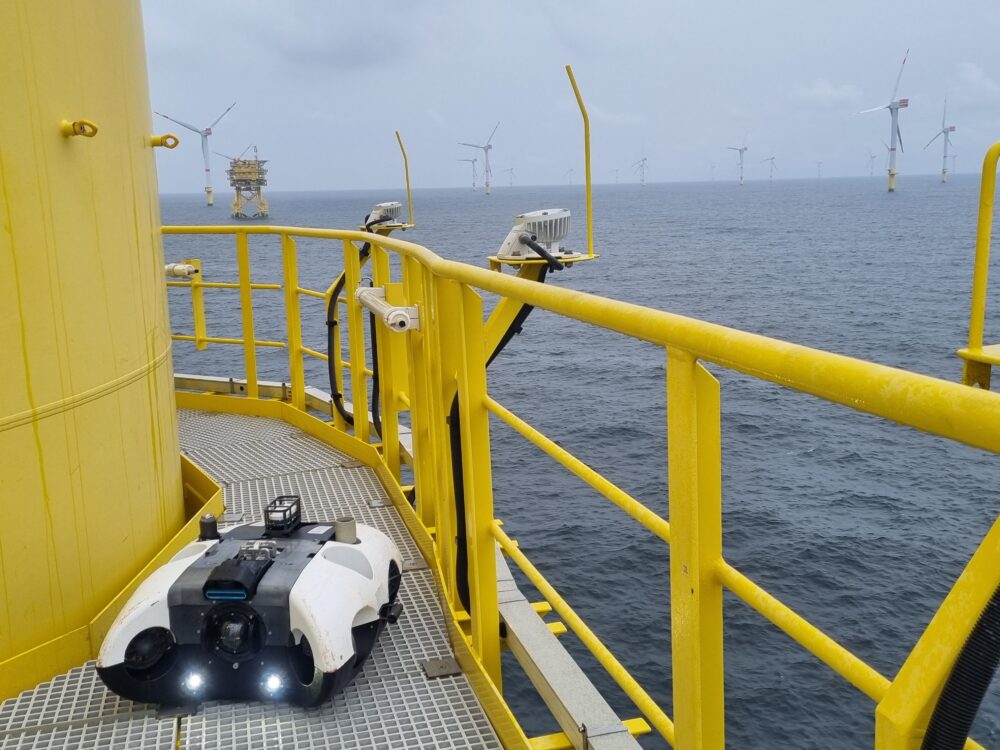Facing increasing pressure to reduce opex as much as is safely possible, offshore operators are warming to drone technology as a support tool for complex, dangerous and time-consuming tasks. While most AUVs are deployed in the oil and gas segment, where they are commonly used for seabed and pipeline inspections, demand for these bots is growing in the offshore renewable energy sector, which is expected to flip oil and gas in terms of spend by the end of the decade.
As one recent example, Nordsee One – developer of the 332MW offshore wind farm of the same name, located in the German North Sea – recently put a new hovering AUV (HAUV) through its paces at the 54-turbine site. The HAUV used was the A.IKANBILIS model, produced by Singaporean drone manufacturer BeeX, which was ‘set loose’ to conduct monopile foundation inspections, including checks of impressed current cathodic protection (ICCP) anodes and cable protection systems (CPS). These tasks typically require the hire and charter of specialist divers and larger support vessels – an additional expense most offshore operators could do without.
The key to the HAUV’s autonomous manoeuvres is its artificial intelligence (AI)-powered Autonomy Engine – effectively the vehicle’s ‘brain’. Functioning as a machine-learning tool, the Autonomy Engine continuously gathers and stores data related to tides, current and visibility, plus previously completed inspections, creating a knowledge base that it can draw upon in future missions. BeeX tells Ship & Boat International: “Most AUVs are torpedo-shaped vehicles used for large area surveys, which means the ‘brain’ is relatively simple: it just keeps a fixed offset from the seabed and moves from Points A to B. We call that ‘automatic’ rather than ‘autonomous’.”
In contrast, BeeX says, the A.IKANBILIS can adapt its motions in real time “as it recognises objects of interest, providing the best data outcome possible”. Using 3D sonar, the HAUV can build up pictures of subsea objects, as well as geo-referencing and time-stamping them. The Autonomy Engine’s CPU enables the vehicle to make instantaneous decisions, based on its current sensor inputs, while its GPU, running in parallel, is where the machine-learning algorithms run in real time.
The A.IKANBILIS measures 900mm x 800mm x 400mm and has a dry weight of 55-65kg, depending on the sensor payload. Developed for tethered and untethered operations, the unit can work to a depth of 300m. The HAUV relies on seven vectored thrusters to manoeuvre, with power provided by two swappable 500Wh battery packs, granting the drone an endurance of seven hours. As some of the HAUV’s target subsea areas will be affected by restricted visibility and high water turbidity, the unit is fitted with lights, rated 4,700lumens, plus an HD camera.
The Nordsee One trials garnered positive feedback. BeeX recalls: “On launch, the vehicle was able to complete its objectives without a human in the loop, autonomously choosing the safest, fastest and most effective way to approach its mission parameters. The geo-referenced reporting of the monopile condition and 3D CPS inspection was provided to the client in near real time via an integrated cloud-based platform, reducing the typical weeks-long wait for traditional reports to mere seconds.” Speaking shortly after the trials, Jan Schmökel, balance of plant engineer at Nordsee One, described the “speed and quality of the data reporting” as “unprecedented”.






